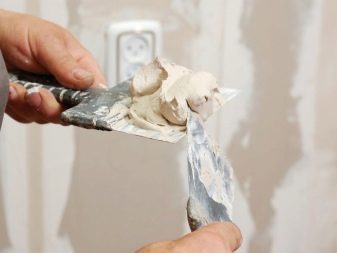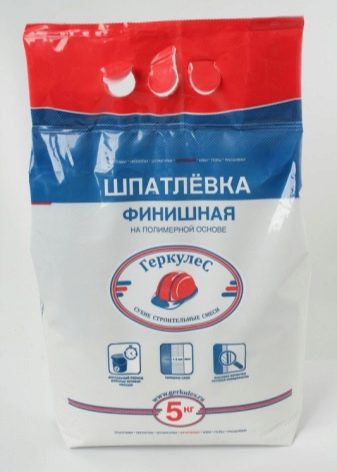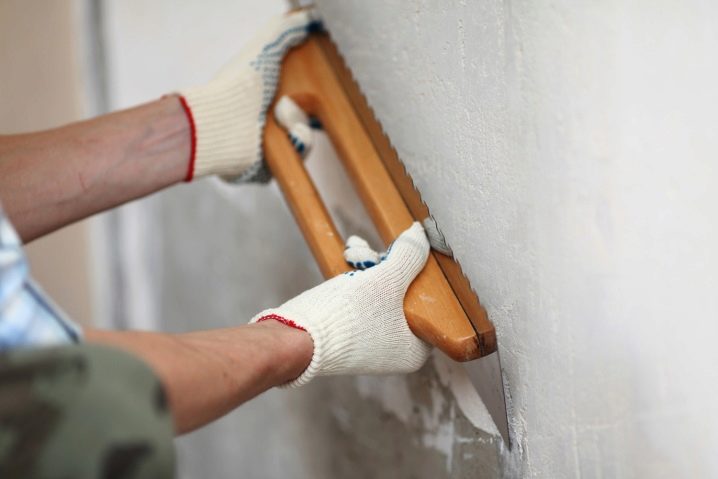Polymer putty: what is it and what is it for

The building materials market is annually replenished with new and improved products. Among the wide assortment, even the most demanding customers can make a choice.
One of the most popular building materials is polymer putty., which is produced not only by domestic, but also by foreign manufacturers. With the help of this material, you can prepare both the floor, and the walls, and the ceiling for further finishing work.

Peculiarities
Many people wonder what a polymer putty is and how it differs from the usual one. The putty is a material with a special composition based on polymers, which is used for leveling all kinds of surfaces in various rooms.


Polymer putty is a relatively new type of material of this type. Despite its novelty, from year to year it is becoming more and more in demand compared to the most common types of putty:
- The polymer material is considered to be more stable and more reliable.
- The solution applied to a particular surface dries much faster than usual.


- During the drying process, no shrinkage is formed, as a result of which the surface remains flat.
- Also, after the material dries, no cracks will form on the walls or on the floor. The putty will not crumble. Of course, for all priming and finishing work to be successful, it is very important not only to purchase quality products, but also to follow all instructions for their preparation and application.


- This type of material is very easy to apply to a wide variety of surfaces. Polymer putty is great for interior work. In addition, you can easily cope with it on your own, without resorting to the help of specialists.
- Thanks to this type of putty, you can quickly prepare the walls for wallpapering or painting.


If we compare the polymer putty with its other varieties, for example, on a gypsum base, we can conclude that the polymer putty is considered more moisture resistant, as a result of which it is ideal for rooms with high humidity levels.
It is also important that such The putty can be applied to a wide variety of surfaces as it has very good adhesion properties. This is due to the fact that it contains special film-forming components and polymers. The name of the material came from the composition.

Varieties
Today on the building materials market you can find several varieties of polymer putties, which include:
- latex;
- acrylic.


Latex options from a variety of companies are used exclusively for interior finishing work, most often for finishing work.
Latex putties have the following advantages:
- They are very durable, ductile and wear-resistant.
- Easy to apply, do not require special preparation skills.
- Safe for humans and the environment. They do not have an unpleasant odor.

In turn, acrylic putties also do not fade into the background, however, their range of application is slightly wider. They can be used not only for internal, but also for external finishing work due to a more stable composition. Very often, acrylic varieties are used for facade decoration. They are considered waterproof, not afraid of moisture and temperature changes.
Also, polymer-cement can be attributed to the varieties of polymer putties.It contains cement, lime and some mineral additives. This putty is suitable for more serious work, such as leveling concrete walls, as well as brick and cement surfaces of various types. Suitable for indoor and outdoor use.


The use of this putty is especially important when there are cracks and any defects on the surface. They can be easily removed with this polymer material.

Which is better?
Latex and acrylic fillers must not be applied to surfaces thicker than 3-5 millimeters. If you need to hide large errors on the surface, as well as serious defects on it, it is best to use a polymer-cement type of putty, which can be applied with a layer of up to 20 mm.
Speaking about polymer-cement putty, it is important to note that its technical characteristics are much higher compared to others. This variety is considered frost-resistant, moisture-resistant, moisture-repellent and environmentally friendly in composition.


Before purchasing a putty, be sure to consider the following points:
- for what finishing work you will need it;
- in what conditions the surface treated with putty will be located (it is imperative to take into account the regular temperature regime, as well as its differences);
- you should choose the right manufacturer in order to purchase high-quality building materials that will serve you for many years.

Manufacturers offer putty in two types: dry and ready-made. Of course, there are fewer problems with the second, because you just have to open the jar with the mixture, and the first will need to be diluted according to the instructions. Nevertheless, the compositions of these products are almost identical. Ready-made options are slightly more expensive, and dry ones will require additional time and effort to prepare them.

Usage Tips
You can even prepare the surface with a putty before important finishing work on your own, without resorting to the help of professionals.
You can apply the putty to the surface with your own hands, since its composition does not require special preparations. It is often sold ready-made. If you chose a powder mixture, then, based on the instructions, it must be properly diluted with water. It is important to fill up the dry putty in parts, that is, in portions, and not all at once.


The putty must not be applied to unprepared surfaces and walls. To begin with, it is very important to clean them of various dirt, grease stains and residues from old finishing materials. In addition, it is very important not to forget about the preliminary priming of the surface. Only after these preparations can a layer of putty be applied.


Manufacturers
The widest range of building materials offers a lot of options for putties for every taste and wallet of the buyer. Further, we recommend that you pay attention to the especially popular and demanded types of putty from various manufacturers.
- Polymer putty Axton Ideal for wallpaper, tiles and other decorative wall coverings. In addition, such a putty is excellent for air permeability.
- Putty Finish Control will help eliminate a variety of surface defects. Made of proven and safe material that does not release toxic substances into the environment even over time.


- Elastic putty deserves special attention. Fibrelastic, which has excellent composition and characteristics.
- We also recommend paying attention to finishing putties. Bolars, Etalon, Polygran and Hercules. All have excellent properties, they are easily suitable for the most real professionals in their field.
- For those who want to purchase a dry mix, it is best to take a closer look at the proven putty called "ShPP-white".


Reviews
Many buyers say that polymer putty from domestic manufacturers is an ideal replacement for conventional options, since it has many advantages.Despite the fact that prices for polymer varieties are higher than for conventional varieties, customers do not refuse to buy them.


Many buyers point out that they even use a polymeric foam putty, since other options are the least suitable. Also, the great strength of the putty was noted by the craftsmen, who used it to level the concrete surface.
Some buyers leave mixed reviews about PVA polymer clay, saying that it is best to purchase conventional acrylic polymer putties ready-made.


Advice
For a high-quality polymer putty coating, do not apply it over gypsum. One solution will be the best option. This is due to the fact that several types of putty can affect the quality of further finishing work.
Plastic putties can reduce material costs and at the same time get the most even surface. In addition, plastic putty dries many times faster than others.

In the prepared form, the putty can be stored for up to twelve hours, the main thing is that the container is tightly closed. This is very convenient, especially if you do not have time to complete the repair work: you can easily continue them later.
An excellent example for leveling the surface of the walls can be the use of polymer putty and a wide trowel. With its help, you will cope many times faster. Be sure to dry the previous one before each subsequent layer.

With the help of polymer putty, walls and ceilings can be treated not only in living quarters in a house or in a country house, but also in a summer veranda or gazebo.

Many experts recommend using a special polymer mesh to level the walls, on top of which putty is applied. With its help, you can get not only a flat surface, but also a durable and wear-resistant layer of material.

All about the superfinishing polymer putty 2 in 1 - KP PRO, see the video below.













The comment was sent successfully.